Zerynthia polyxena
| Southern festoon | |
|---|---|
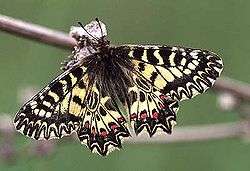 | |
| Dorsal view | |
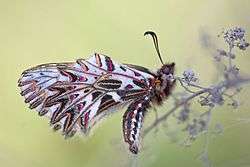 | |
| Lateral view | |
| Scientific classification | |
| Kingdom: | Animalia |
| Phylum: | Arthropoda |
| Class: | Insecta |
| Order: | Lepidoptera |
| Family: | Papilionidae |
| Genus: | Zerynthia |
| Species: | Z. polyxena |
| Binomial name | |
| Zerynthia polyxena (Denis & Schiffermüller, 1775) | |
| Synonyms | |
Zerynthia polyxena, the southern festoon, is a striking butterfly belonging to the family Papilionidae of butterflies. Its flight time is from April to June in a single brood.
Description
The southern festoon can reach a wingspan of 60–80 mm. The females have slightly longer wings, usually lighter colored than males. The basic color of the wings is yellow, but they have a complicated pattern of several black bands and spots. On the edges of the hindwings they have a series of blue and red warning spots to deter potential predators. The body is dark brown and bears red patches on the sides of the abdomen.
This butterfly can be confused only with the Spanish festoon (Z. rumina). The differences are in the presence of blue on the hind wings of Z. polyxena and the relatively lower amount of red on its forewings as compared to Z. rumina.
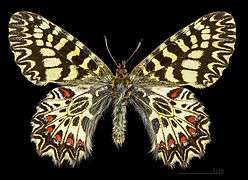 Male
Male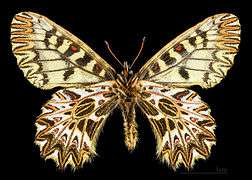 Male bottom
Male bottom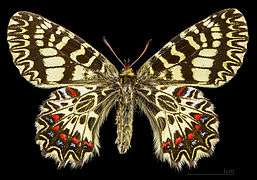 Female
Female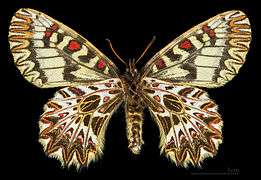 Female bottom
Female bottom
The caterpillars of Z. polyxena are up to 35 millimeters long. They are initially black, then they are yellowish with six rows of fleshy orange and black spikes all over the body. They feed on birthworts (Aristolochia sp.), mainly (Aristolochia clematitis and Aristolochia rotunda). The special food of the larvae provides the toxic substances which then also go to the adults, making them inedible.
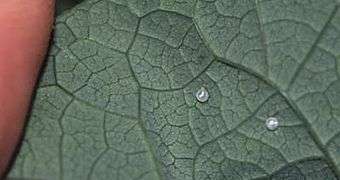 Eggs
Eggs Young caterpillar
Young caterpillar
Development
The adults are active for no more than three weeks. The females lay their eggs singly or in small groups at the bottom of the host plants. The eggs are spherical and whitish at first, bluish colored before hatching. The young caterpillars feed at first on flowers and young shoots, while after the second molt they feed on leaves. The pupae stay linked to a support by a silk belt for wintering and the new adults hatch the next spring.
Distribution

Z. polyxena is widespread in the middle and southern Europe (southeastern France, Italy, Slovakia and Greece) covering all the Balkans and reaching the south of Kazakhstan and the Urals. Although they are widespread they occur only locally.[2][3]
Habitat
These butterflies can be found in warm, sunny and open places such as vineyards, river banks, wetlands, cultivated areas, brushy places, wasteland, rocky cliffs and karst terrains, at an elevation of about 1,700 meters above sea level, but usually under 900 meters.
Subspecies and forms
- Zerynthia polyxena polyxena (Denis & Schiffermüller, 1775) in Italy
- Zerynthia polyxena polyxena f. punctata Schultz, 1908
- Zerynthia polyxena polyxena f. marpha Schultz, 1908
- Zerynthia polyxena polyxena f. rubra Hoffmann], 1916
- Zerynthia polyxena polyxena f. bella Neuburger, 1903
- Zerynthia polyxena polyxena f. bipunctata Cosmovici, 1892
- Zerynthia polyxena polyxena f. meridionalis Hoffmann, 1916
- Zerynthia polyxena polyxena f. tripunctata Zelezny, 1916
- Zerynthia polyxena polyxena f. nora Schultz, 1908 (kreusa Tomala)
- Zerynthia polyxena polyxena f. muelleri Bryk, 1921 (mulleri Bryk, recte muelleri)
- Zerynthia polyxena polyxena f. springeri Ronnicke, 1906
- Zerynthia polyxena polyxena f. reducta Zelezny, 1915
- Zerynthia polyxena polyxena f. nigromaculata Zelezny, 1915
- Zerynthia polyxena polyxena f. unimaculata Zelezny, 1915
- Zerynthia polyxena polyxena f. demaculata Schultz, 1908
- Zerynthia polyxena polyxena f. confluens Schultz, 1908
- Zerynthia polyxena polyxena f. lateviltata Schultz, 1908
- Zerynthia polyxena polyxena f. fasciata Begrer, 1919
- Zerynthia polyxena polyxena f. skalae Zelezny, 1917
- Zerynthia polyxena polyxena f. derubescens Zullich, 1928
- Zerynthia polyxena polyxena f. alba Esper, 1805
- Zerynthia polyxena polyxena f. subalba Schultz, 1908
- Zerynthia polyxena polyxena f. rufescens Oberthur, 1879
- Zerynthia polyxena polyxena f. meta Meigen
- Zerynthia polyxena polyxena f. ochracea Staudinger, 1861
- Zerynthia polyxena polyxena f. cellopura Eisner
- Zerynthia polyxena polyxena f. basinigra Eisner
- Zerynthia polyxena polyxena f. quincunx Eisner
- Zerynthia polyxena polyxena f. divisa Schultz, 1908
- Zerynthia polyxena polyxena f. ornata Eisner
- Zerynthia polyxena polyxena f. vitrina Rothschild
- Zerynthia polyxena polyxena f. irregularis Holland
- Zerynthia polyxena aemiliae (Rocci, 1929) in North Italy; Lombardy: Massa Lombarda, Modena, Livorno
- Zerynthia polyxena albanica (Riemel, 1927) in Albania
- Zerynthia polyxena australis Esper, 1780 (medesicaste Hoffmannsegg) (south France: Provence - east Pyrenees)
- Zerynthia polyxena australis f. alicea Neuburger, 1903
- Zerynthia polyxena australis f. paucipunctata Neuburger
- Zerynthia polyxena australis f. tristis Verity
- Zerynthia polyxena australis f. divisa Schultez
- Zerynthia polyxena australis f. hartmanni Staudfuss, 1896
- Zerynthia polyxena australis f. unipunctata Eisner, 1954
- Zerynthia polyxena australis f. minusculus Eisner
- Zerynthia polyxena australis f. vitrina Rothschild sensu Eisner
- Zerynthia polyxena australis f. aperta Eisner, 1954
- Zerynthia polyxena australis f. quincunx Eisner
- Zerynthia polyxena australis f. honnerathii Boisduval, 1832
- Zerynthia polyxena australis f. albescens Eisner
- Zerynthia polyxena australis f. binaria Eisner
- Zerynthia polyxena bosniensis (Eisner, 1974) in Bosnia
- Zerynthia polyxena bosniensis f. ochracea Staudinger, 1861
- Zerynthia polyxena bosniensis f.reducta Zelzny, 1915
- Zerynthia polyxena bryki (Eisner, 1954) in Montenegro, Herzegovina border
- Zerynthia polyxena cantabrica Gomez-Bustille (Spain: Cantabrica)
- Zerynthia polyxena carmenae (Sabariego et Martinez, 1991) in Bulgaria
- Zerynthia polyxena cassandra (Geyer, 1828) in south France, north Italy
- Zerynthia polyxena cassandra f. ochracea Staudinger, 1861
- Zerynthia polyxena cassandra f. vitrina Rothschild, 1918
- Zerynthia polyxena cassandra f. inornata Pionneau
- Zerynthia polyxena cassandra f. bella Neuburger
- Zerynthia polyxena cassandra f. reducta Železný, 1915
- Zerynthia polyxena cassandra f. quincunx Eisner
- Zerynthia polyxena cassandra f. microcreusa Verity, 1947
- Zerynthia polyxena cassandra f. deminuta Verity, 1947
- Zerynthia polyxena cassandra-clara (Verity, 1947) in Croatia
- Zerynthia polyxena castiliana Ruhl, 1892 (transcastilia Mon) (Central Spain: Castilia, Albarracín)
- Zerynthia polyxena castiliana f. derubescens Schultz
- Zerynthia polyxena castiliana f. honnorathii Boisduval, 1832 (henrietta Timmins)
- Zerynthia polyxena castiliana f. tristis Verity, 1906
- Zerynthia polyxena castiliana f. semitristis de Sagarra, 1930
- Zerynthia polyxena castiliana f. ornatissima Blachier, 1908
- Zerynthia polyxena castiliana f. nigricans Holland
- Zerynthia polyxena castiliana f. alicea Neuburger, 1903
- Zerynthia polyxena catalonica de Sagarra 1930 (Spain: Catalonia)
- Zerynthia polyxena catalonica f. semitristis de Sagarra, 1930
- Zerynthia polyxena caucasiae (Nardelli & Hirschfeld, 2002) north west of Caucasus
- Zerynthia polyxena creusa Meigen, 1829 (central Italy: Ventimiglia (Verity, 1950), cf. Eisner, 1974!)
- Zerynthia polyxena decastroi (Sala & Bollino, 1992) in Italy
- Zerynthia polyxena deminuta (Verity, 1947) southern of France
- Zerynthia polyxena demnosia Freyer, 1833 (Dahl MS) (albanica Riemel], thusnelda Schultz) (= ssp. macedonia Eisner, 1974 (Macedonia, Thessalia, Dalmatia, Albania)
- Zerynthia polyxena demnosia f. quincunx Eisner
- Zerynthia polyxena demnosia f. vitrina Rothschild
- Zerynthia polyxena demnosia f. ochracea Staudinger, 1861
- Zerynthia polyxena gracilis (Schultz, 1908) in north-east Turkey: Brusa, Karagja Dagh
- Zerynthia polyxena idaensis (Eisner, 1974) in Crete
- Zerynthia polyxena idaensis f. rumina Linne, 1758
- Zerynthia polyxena latevittata (Verity, 1919) in Sicily
- Zerynthia polyxena latiaris (Stichel, 1907) in south Italy: Calabria, Rome, Monti Albani
- Zerynthia polyxena linnea (Bryk, 1932) in Italy, Elba
- Zerynthia polyxena macedonia (Eisner, 1974) in Macedonia
- Zerynthia polyxena michaelis (Nardelli, 1993) in Italy
- Zerynthia polyxena microcreusa (Verity, 1947) southern of France
- Zerynthia polyxena minima Gerhardinger, 1951 Spain: Toledo)
- Zerynthia polyxena nemorensis (Verity, 1919) in Italy: Toscana, Firenze.
- Zerynthia polyxena nigra (Sijaric, 1989) in Bosnia
- Zerynthia polyxena padana (Rocci, 1929) in north Italy: Piedmont, Lombardy, Turin
- Zerynthia polyxena patrizii (Nardelli, 1993) in Italy
- Zerynthia polyxena petheri Romei, 1927 (south Spain: Sierra Nevada)
- Zerynthia polyxena petri (Bryk, 1932) in Greece, south Ukrainskaja: Cherson, Kiev, lower Juzinyi Bug, Krim
- Zerynthia polyxena polymnia (Millière, 1880) in Greece: Euboea
- Zerynthia polyxena reverdinii (Fruhstorfer, 1908) in west and north Italy: Liguria.
- Zerynthia polyxena silana (Storace, 1962) in Italy
- Zerynthia polyxena sontae (Sijaric, 1989) in Serbia
- Zerynthia polyxena taygetana (Rosen, 1929) in Greece: Taygetus, Peleponesos
- Zerynthia polyxena thesto Fruhstorfer, 1908 in south-west U.S.S.R.: lower Volga, Saratow, lower Don
- Zerynthia polyxena thesto f. rufescens Oberthur, 1879
- Zerynthia polyxena thesto f. muelleri Bryk, 1991
- Zerynthia polyxena thesto f. cellopura Eisner
- Zerynthia polyxena tristis de Lattin, 1950 in Turkey
- Zerynthia polyxena vipsania Hemming, 1941 (:latevittata Verity, 1919, a secondary homonym of latevittata Schultz, 1908: creusa Mann, nec Meigen, Dahl MS: polymnia Ragusa, 1906, (Sicily)[1][3]
References
External links
- European Butterflies and Moths
- Moths and Butterflies of Europe and North Africa
- Globis Gart
-
 Media related to Zerynthia polyxena at Wikimedia Commons
Media related to Zerynthia polyxena at Wikimedia Commons